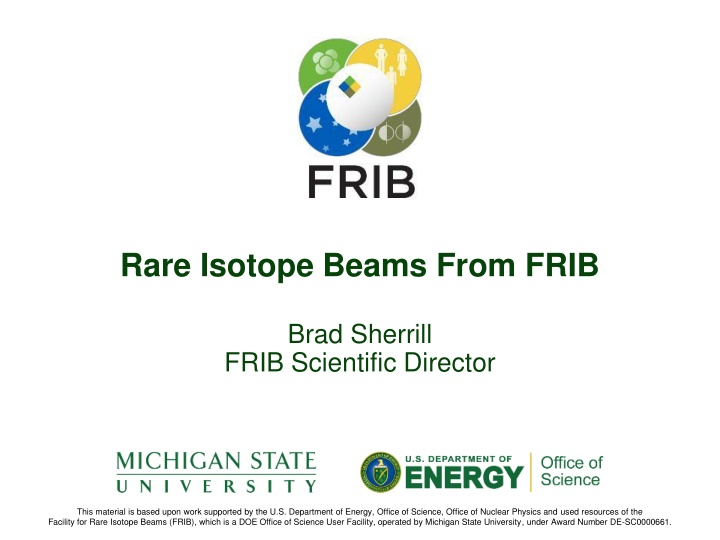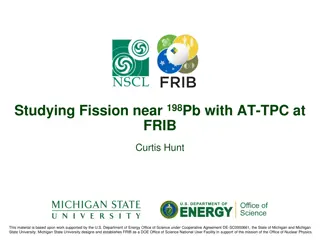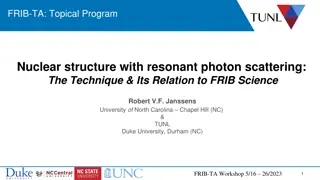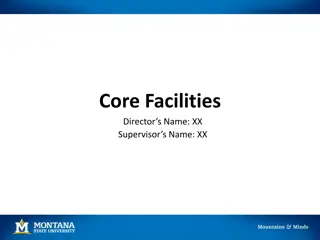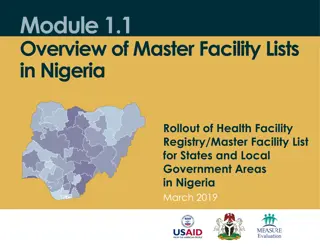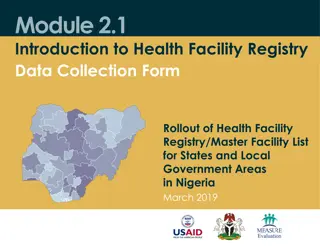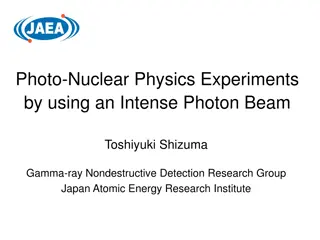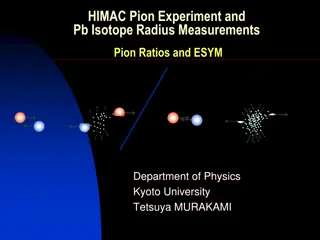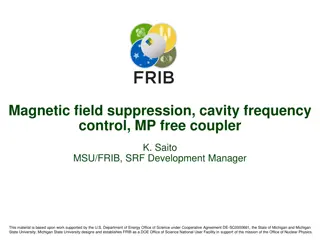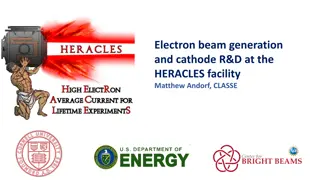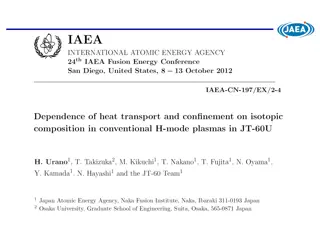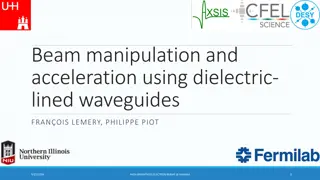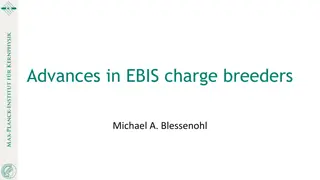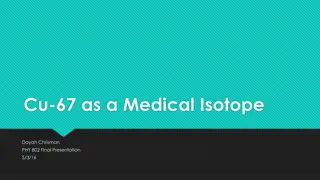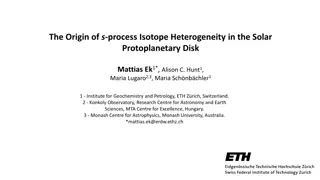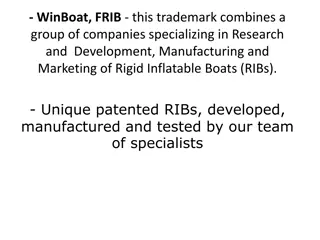Rare Isotope Beams from FRIB - Facility Overview and Operations
FRIB (Facility for Rare Isotope Beams) is supported by the U.S. Department of Energy and Michigan State University. It utilizes advanced techniques for rare isotope beam formation, offering insights into nuclear physics. The facility operates with high beam power, serving various scientific experiments to meet user requirements efficiently.
Download Presentation

Please find below an Image/Link to download the presentation.
The content on the website is provided AS IS for your information and personal use only. It may not be sold, licensed, or shared on other websites without obtaining consent from the author.If you encounter any issues during the download, it is possible that the publisher has removed the file from their server.
You are allowed to download the files provided on this website for personal or commercial use, subject to the condition that they are used lawfully. All files are the property of their respective owners.
The content on the website is provided AS IS for your information and personal use only. It may not be sold, licensed, or shared on other websites without obtaining consent from the author.
E N D
Presentation Transcript
Rare Isotope Beams From FRIB Brad Sherrill FRIB Scientific Director This material is based upon work supported by the U.S. Department of Energy, Office of Science, Office of Nuclear Physics and used resources of the Facility for Rare Isotope Beams (FRIB), which is a DOE Office of Science User Facility, operated by Michigan State University, under Award Number DE-SC0000661.
FRIB Estimated Beam Rates https://groups.nscl.msu.edu/frib/rates/fribrates.html Beams: Fast Stopped Reaccelerated Log O. Tarasov, et al. EPAX 2.15 B. Sherrill, May 2023 FRIB TA Workshop, Slide 2
Rare Isotope Beam Formation FRIB uses the in-flight , stopping, and reacceleration scheme Fragment Separator Accelerator Beam Post Acceleration Gas catcher/ solid catcher + ion source Cartoon of the isotope production process projectile fragmentation or projectile target 122Zr production cross section (from 136Xe) is estimated to be 2x10-18 b With a 136Xe beam of 8x1013 ion/s (400 kW at 200 MeV/u) a few atoms per week can be made and studied FRIB may be able to make 80% of all possible nuclides up to Uranium B. Sherrill, May 2023 FRIB TA Workshop ,Slide 3
Schematic Overview of the FRIB Facility High power heavy ion accelerator (200 MeV/u, 400 kW for all beams Oxygen to Uranium) Superconducting linear accelerator with 3 segments 46 total cryomodules Three-stage fragment separator Fast, Stopped and Reaccelerated beams available ReA3,6 (up to 10 MeV/u re- accelerator); can operate in stand- alone mode Stopped Beam Area Pre-separator Accelerator B. Sherrill, May 2023 FRIB TA Workshop, Slide 4
FRIB Operates at 5 kW Beam Power Meeting Scientific User Requirements FRIB accelerator has steadily ramped up beam power to 5 kW Serving multiple experimental areas 4100 4400 hours scheduled annually for scientific experiments Objective Measures Date Power Beam commissioning on user run May 2022 User experiment 21062 at FDSi May 2022 1 kW User experiment 21069 at FDSi Jun 2022 1 kW User experiment 21007 at S800 Aug 2022 1 kW User experiment 21072 at FDSi Nov 2022 3 kW User experiment 21003 at S800 Dec 2022 3 kW User experiment 22601 at N4 Dec 2022 3 kW User experiment 23602 at N4 Jan 2023 3 kW User experiment 22501 at TH Feb 2023 3 kW User experiment 21049 at N4 Feb 2023 5 kW User experiment 21009 at S800 Mar 2023 5 kW B. Sherrill, May 2023 FRIB TA Workshop, Slide 5 User experiment 21034 at S800 Apr 2023 5 kW
More than 200 Rare Isotope Beams Have Been Delivered to FRIB Experiments Most Recent Experiments: E21034: 82Sr, 83,84Y, 84,85Zr, 85,86Nb, 87Mo, 88Tc, 89Ru E21009: 42,44S, 43-45Cl E22501: 175-182Tm, 176-185Yb, 178-189Lu, 181-193Hf, 185-196Ta, 186-197W, 191-198Re E21003: 104,106Sn, 102,103,105In, 101,102,104Cd, 100,101,103Ag E21062:16-20C, 19-23N, 22-24O, 19-27,29F, 29-32Ne, 30-35Na, 33-38Mg, 35-41Al, 39-43Si, 43-45P Protons Primary Beams 36Ar 48Ca 70Zn 82Se 124Xe 198Pt Stable isotopes Observed isotopes Experiments at FRIB Data Date: 2023-04-11 A. Stolz Neutrons Stolz B. Sherrill, May 2023 FRIB TA Workshop, Slide 6
On Track to Deliver FY23 Operations Hours Ensuring High User Availability while Ramping Up Power FRIB will deliver 3600 achieved hours at planned funding level FY23 cumulative hours by 31 March 2023: 2150 scheduled hours, 1895 achieved hours; Availability 88% Operating at Operational Safety Envelope (OSE) of 5 kW primary beam power since Feb 2023 Annually 4100 4400 hours scheduled for scientific experiments; 2000 hours scheduled for industrial applications B. Sherrill, May 2023 FRIB TA Workshop, Slide 7
Planned Phased Implementation of Improvements for Power Ramp Up EPOCH Beam Power ARTEMIS, light ion beams from gas ARTEMIS, heavy ion beams from metal High Power ECR, gas beams High Power ECR, metal beams High power charge selector in FS1 Post-stripper chicane Additional beam collimation in FS2, BDS Dual charge state heavy ions upstream of the stripper (velocity equalizer) Rotatable Target, 1 slice Rotatable Target, multi-slice Post-target shield Beam dump 6 slant (S-shape) Beam dump 6 slant (S-shape), better cooling Rotatable beam dump, 1-mm wall Rotatable beam dump, 0.5-mm wall Medium power ladder wedge system with adjustable slits (hands-on) High Power wedge system (remote handling) PPS upgrade with fast ionization chambers 1 2 3 4 5 6 10 kW 20 kW 50 kW 100 kW 200 kW 400 kW J. Wei and P. Ostroumov B. Sherrill, May 2023 FRIB TA Workshop, Slide 8
Prediction of Rates and Purity is Experimental The rates and purities depend on many factors Reaction mechanism and production cross section (uncertain cross sections by 100 x) Secondary reactions in the target can be relevant (100x gain for some fragments) How to stop high power beam and other fragments (limits some operation) Experimental constraints of energy, momentum and angular range, bad contaminants, good contaminates Rate ( , Separation Efficiency, Charge State Fraction, Reactions) Experimental studies of production cross sections (see for example O. Tarasov et al., Phy Rev C87, 054612) B. Sherrill, May 2023 FRIB TA Workshop, Slide 9
Rare Isotope Production at FRIB Will Improve with Study LISE++ simulations indicates 4,500 isotopes can be produced at FRIB in useful quantities The production cross sections are uncertain by a factor of 3 near stability and more than 100x away from stability The optimum production mechanisms for very extreme isotopes is not well known Techniques for delivering desired purities (sometimes a mix is desired) will be explored and improved B. Sherrill, May 2023 FRIB TA Workshop, Slide 10
FRIB Energy Upgrade to 400 MeV/nucleon Science Case Made, Technology Being Demonstrated Community made science case Access to key regions needed to model nucleosynthesis in neutron- star mergers Luminosity gain over 50 for rarest isotopes Energy better matched to exploring nuclear equation of state for neutron-star merger Energy better matched for knockout and charge-exchange reactions LINAC Upgrade Add 11 cryomodules, each with five b=0.65 elliptical cavities operating at 644 MHz FRIB400 SRF Cavity R&D Progress FRIB400 Design goal FRIB400 White Paper Demonstrated that the design goal can be met with standard ILC EP. Pursuing R&D on advanced surface treatment such as nitrogen doping (see right) P Ostromouv et al. FRIB Linac Layout with Upgrade Cryomodules B. Sherrill, May 2023 FRIB TA Workshop, Slide 11
FRIB400 Scientific Reach Extended Drip line extended to Z 60 Blue FRIB400 reach Red FRIB200 reach B. Sherrill, May 2023 FRIB TA Workshop, Slide 12
Production Rate of 100Sn Illustrates the Future Gains (approximate) Hypothetical increase over time; no promises, rates at the experiment will be lower FRIB start of operations: 1 kW December 2022: 3 kW (0.04/s measured) EPOCH 1: 10 kW (0.1/s) EPOCH 2 2025: 20 kW (0.25/s) EPOCH 3 2026: 50 kW (0.8/s) EPOCH 4 2027: 100 kW (2/s) EPOCH 5 : 200 kW (4/s) EPOCH 6 2029: 400 kW (8/s) TBD: FRIB400 (40/s) To be TBD: FRIB400 with a lithium target upgrade (250/s) B. Sherrill, May 2023 FRIB TA Workshop, Slide 13
Isotope Harvesting at FRIB Infrastructure funded by DOE Isotope Program Many rare isotopes are produced but only one isotope delivered to single user Often 1000 other isotopes are produced that could be harvested and used for experiments or applications Isotope harvesting done during routine operation for FRIB s nuclear physics mission without interfering with FRIB s primary users Medical tracers (52Fe/52mMn), theranostics (Cu,Sc), biological catalysts, micro batteries, homeland security, fundamental symmetries tests FRIB had provisions for isotope harvesting incorporated in the design Hot cells ordered with support from DOE Isotope Program and laboratory being prepared in MSU- provided building Implementing commensal isotope harvesting capabilities from FRIB beam dump water Operational in 2023 Abel et al 2019 J. Phys. G: Nucl. Part. Phys. 46 100501 Contributors: MSU, LLNL, LANL, ANL, Missouri, Alabama, ND, ORNL, BNL, Iowa B. Sherrill, May 2023 FRIB TA Workshop, Slide 14
Backup B. Sherrill, May 2023 FRIB TA Workshop, Slide 15
